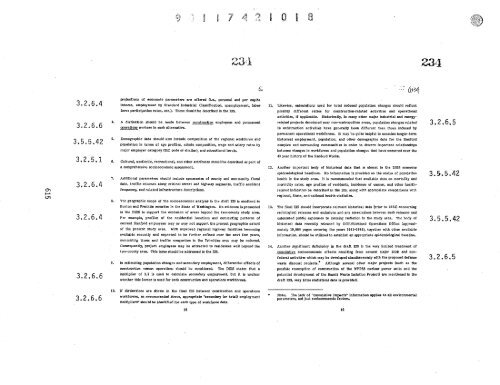EIS-0113_Section_11 - Hanford Site
EIS-0113_Section_11 - Hanford Site
EIS-0113_Section_11 - Hanford Site
Create successful ePaper yourself
Turn your PDF publications into a flip-book with our unique Google optimized e-Paper software.
TR<br />
23<br />
234<br />
(P<br />
3.2.6.4<br />
3.2.6.6<br />
3.5.5.42<br />
projections of economic parameters are offered (i.e., personal and per capita<br />
income, employment by Standard Industrial Classification, unemployment, labor<br />
force participation rates, etc.). These should be described In the <strong>EIS</strong>.<br />
4. A distinction should be made between eorstruc ton employees and Permanent<br />
aW rations workers In each alternative.<br />
5. Demographic date should also include composition of the regional workfare. and<br />
population in terms of age profiles, ethic composition, wage and salary rates by<br />
major employer estegory (SIC lode or similar), and canard ... I basis.<br />
3.2.5.1 8. Culture], aesthetic, rccreotlonsl, and other attributes should be described as part of<br />
e comprehensive socioeconomic assessment.<br />
s. Additional parameters should summaries, of county and community fiscal<br />
3.2.6.4<br />
data, traffic volumes along critical street and highway segmen., traffic accident<br />
frequency, and related infrastructure descriptions.<br />
a. The geographic scope of the socioeconomic analysis in the draft <strong>EIS</strong> is confined to<br />
Benton and Pranklrn counties In the State of Washligton. No evidence is presented<br />
in the D12S to simport the exclusion of areas lanyard the two,aunty study men.<br />
3.2.6.4 Par example, profile; of the residential locations end contracting patterns of<br />
current <strong>Hanford</strong> employees may or may not support the present geographic extent<br />
of the present study area With improved regional highway facilities becoming<br />
3.2.6<br />
available recently and expected to be fmNer refined over the next few years,<br />
commuting times end Ir ffie congestion In the Tri-ciees roes may be retluced.<br />
Consequently, project employees may be attracted to realdenees well beyond the<br />
two-c ... I, area. This issue should be addressed in the M.<br />
S. N estimating population changes and secondary employment, differential effects of<br />
construction versus operations should be considered The DM states that a<br />
. 6<br />
multiplier of 1.2 is used to calculate secondary employment, but it is unclear<br />
L V<br />
whether this factor is used for both construction and operations wrckforees.<br />
6<br />
<strong>11</strong>. Likewise, ealculati.. card for total induced population check. should reflect<br />
possibly different ratios for construction-related activities and operational<br />
activities, if applicable. Historically, in many other major industrial and energyrelated<br />
projects developed near non-metropolitan arses, population changes related 3.2.6.5<br />
to cousfruetioe activities have ga mall, been different than Nose induced by<br />
permanent operational workforc o. It may be quite helpful to examine longer-term<br />
historical employment, population, and other demographic date for the <strong>Hanford</strong><br />
complex and surrounding communities in order to discern important relationships<br />
between changes in workforees and population .barges net have occurred over the<br />
43 year history of the <strong>Hanford</strong> Works.<br />
12. Another important body of historical data that Is absent in the D<strong>EIS</strong> concerns<br />
epidemiological baseEnes. No Information Is provided on the states of population 3.5.5.42<br />
health in the study er gs. It is recommended that available data on mortality and<br />
morbidity rates, age profiles of residents, incidence of cancer, and other healthrelated<br />
indicators he described in the <strong>EIS</strong>, along with appropriate nompsrlsouv with<br />
regional, Steve, end national health statistics.<br />
13. The final <strong>EIS</strong> should incorporate relevant historical date (prior to 1984) concerning<br />
radiological releases sad emissions end any a ... rletions between such releases and<br />
calculated public exposures to Ionizing radiation In the study area. The body of<br />
3.5.5.42<br />
historical data recently released by DOE/Richland Operations Office (approximately<br />
19,000 pages covering the years 1943-1984), together with other available<br />
information, should be utilized to establish me appropriate epidemiological baseline.<br />
14. Another significant deficieneg in the draft End k the very limited treatment of<br />
cum ulative socioeconomic effects resulting from several major DOE and nonfederal<br />
activities which may be developed simelteneously with the proposed defense 3.2.6.5<br />
waste disposal projects.* Although several other major projects (such m the<br />
possible resumption of construction of the WPPSS nuclear power units end the<br />
potential development of the Basalt Waste LsoleLon Project) ere mentioned in the<br />
draft 09, very little statistical &to is provided.<br />
3.2.6.6<br />
10. if d istinctions are shown in the final <strong>EIS</strong> between comlumation and operations<br />
workforces, as recommended above, appropriate "secondary, (or toml) employment<br />
multipliers" should be identified for each type of workforce data.<br />
15<br />
• .Note: The leek of "cumulative Impacts" information applies to a environmental<br />
parameters, not just socioeconomic factors.<br />
16

















